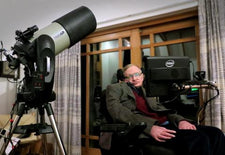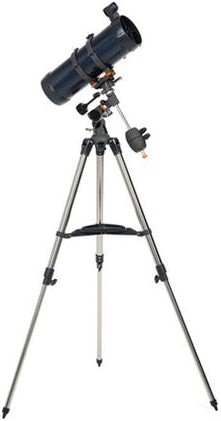Celestron SkyAlign
May 4, 2015

With SkyAlign, setting up and using a computerized telescope is faster and easier than ever before.
Point the telescope at three bright objects in the sky and the telescope tells YOU what the objects are. You do not need to know the names of the stars - you can even pick the moon or bright planets! SkyAlign is the easiest method to align a computerized telescope; it's perfect for beginners and provides the convenience and accuracy demanded by experienced users.
Input the date, time and your location (GPS models obtain all this information automatically) and then point the telescope at three bright stars of your choosing. There is no need to point the telescope north or to level the optical tube as in previous alignment methods. The initial position of the telescope is irrelevant. This makes for a fast and very easy method for aligning the telescope.
What is Alignment?
You have to know where you are in order to find your destination - that is what aligning a computerized telescope is all about. The software for the telescope needs to know the exact orientation of the telescope in relation to the night sky in order to find the tens of thousands of celestial objects programmed in the hand control.
Taking the Guesswork out of Alignment
Other methods for aligning a computerized telescope require the user to confirm what star the telescope is pointing at in order to align. If you don't know where Arcturus or Sirius is, how can you confirm that information? The best you can do is guess. SkyAlign is the only alignment method where you truly do not have to know the night sky - and it's only available from Celestron.
How does it work?
The NexStar software with SkyAlign measures the distance in each axis between the objects you selected. Given the current time and location, the software then compares the data to the expected distances of objects in the hand control's internal database . Once matches are found, the hand control displays the names of the three objects you selected to help you learn the night sky.
FAQ:
-
What telescopes feature SkyAlign?
SkyAlign technology is standard in the CPC, NexStar SLT, NexStar 80 GTL and NexStar 8i Special Edition (available only with 11022-XLT-SE-SA models). -
Will SkyAlign work with equatorial scopes or if my alt/az scope is on a wedge?
SkyAlign is not currently available for telescopes mounted equatorially (or on a wedge). -
Will SkyAlign work with my older Celestron computerized telescope?
SkyAlign will work with alt/az Celestron telescopes that use the NexStar software (excluding the original NexStar 5 and NexStar 8 models). A new hand control will be required for this purpose. Please contact Celestron Technical Support for more information on obtaining an upgraded hand control. Upgraded hand controls that feature SkyAlign are also flash-upgradeable, allowing you to download software updates from the Celestron website. - What steps can I take to ensure successful alignment with SkyAlign?
- Level the tripod
Be sure to level the tripod before you start. Assumptions about the available bright stars and planets rely on a level tripod. Once the alignment is complete, GoTo and tracking are not dependent upon the accuracy with which you leveled the tripod, so do not spend time seeking perfect level - close is good enough. The CPC and NexStar SLT telescopes feature bubble levels on the tripod to assist with this. - Set correct time
If you do not have a GPS-equipped telescope, be accurate to within a couple of minutes when entering the time. Also, either select a city within 50 miles or enter your longitude and latitude to within one degree. - Pick bright stars
Only stars of magnitude 2.5 or brighter are included in the SkyAlign procedure, so it is best to take a look around and select three of the brightest stars in the sky. No need to worry about confusing planets for stars - SkyAlign works with the four brightest planets as well (Venus, Jupiter, Saturn and Mars). Also, you can even use the Moon as one of your alignment objects - though due to the speed with which it moves across the sky and the size, you would need to switch to a low power eyepiece to center it. - Pick stars that are far apart from each other. It is helpful to select widely placed objects for alignment. When scanning the sky before you begin, keep this in mind. Only two of the objects (the two with widest separation) will actually be used for calculating the model of the sky. The third object is needed to provide a positive identification of the other two. So, be sure at least two of the three are widely spaced.
-
What are the steps of the SkyAlign procedure?
- Level the tripod.
- Setup the scope in alt-az mode - mounted right on top of the tripod. SkyAlign is not currently available when mounted equatorially on a wedge.
- Power up the scope.
- Press ENTER to begin and then ENTER again when the display reads SkyAlign. The hand control will show either the current time or the time when you last used the scope. The top line of the display will cycle through the messages, "Enter if OK", and "UNDO to edit". *
- If your scope has a GPS module, the GPS receiver will shortly lock onto 3 GPS satellites and update the date, time, and location (skip to step 6).
- If you become impatient waiting for a GPS link, or if you don't have a GPS module in your scope, use the Up and Down buttons (6 and 9 on the keypad) to scroll through the date, time, and location settings. If they are all correct, press Enter to accept and proceed with the alignment. If they need to be adjusted, press Undo and make any necessary corrections. Then you will see a short message about what will happen next - press ENTER to continue.
- The display will now prompt to Center Object 1. Prior to beginning, you should scan across the sky looking for three bright points. Two of them should have wide separation, the third should not be close to the line connecting the other two.
- Use the arrow buttons to slew (move) to the first of your bright objects. Center the object in the finderscope and press ENTER. Then center the object in the eyepiece and press ALIGN.
- Repeat Step 7 for two additional objects and you are finished
- The hand control displays "Match Confirmed" and then asks you if you'd like to see the matches (hit Enter) or just carry on (hit Undo). If you hit Enter to see the matches, it brings up a list of the matches that you can scroll through.
* entering the time will vary depending on the mount type.



